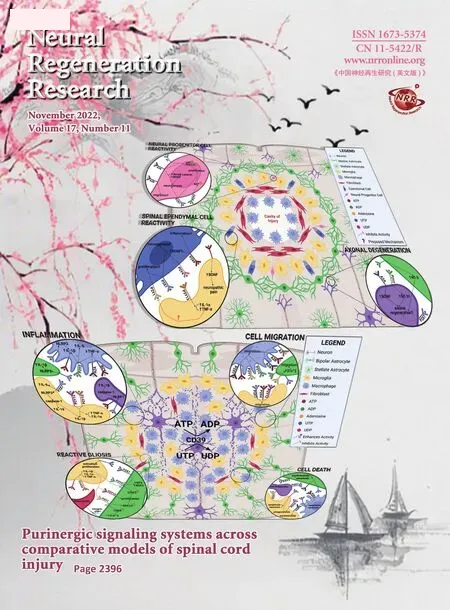中国神经再生研究(英文版)
Reviews
- Interplay of SOX transcription factors and microRNAs in the brain under physiological and pathological conditions
- Cerebellar pathology in motor neuron disease:neuroplasticity and neurodegeneration
- Neuroinflammation as a mechanism linking hypertension with the increased risk of Alzheimer’s disease
- An atypical ubiquitin ligase at the heart of neural development and programmed axon degeneration
- The endogenous progenitor response following traumatic brain injury: a target for cell therapy paradigms
- The relationship between amyloid-beta and brain capillary endothelial cells in Alzheimer’s disease
- Telomerase and neurons: an unusual relationship
- MicroRNAs as biomarkers in glaucoma and potential therapeutic targets
- Neuroprotection and neuroregeneration: roles for the white matter
- Emerging blood exosome-based biomarkers for preclinical and clinical Alzheimer’s disease:a meta-analysis and systematic review
- Purinergic signaling systems across comparative models of spinal cord injury
- Advancements in our understanding of circular and long non-coding RNAs in spinal cord injury
- The uPA/uPAR system in astrocytic wound healing
- The influence of gut microbiota alteration onage-related neuroinflammation and cognitive decline
Perspectives
- Verapamil, a possible repurposed therapeutic candidate for stroke under hyperglycemia
- Engineering cerebral folding in brain organoids
- Non-canonical role of the ATR pathway in axon regeneration as a mechanosensitive brake
- Beyond vertebrates: the amphioxus as a relevant model system to explore the formation, organization,and regeneration of neuromuscular synapses
- Targeting O-GlcNAcylation in ischemic stroke
- Utilizing multiphoton imaging and integrative clearing to reveal sex differences in neuroimmune interactions after nerve injury
- The left-right side-specific endocrine signaling: implications for neurological deficits in stroke and neurodevelopmental disorders
- Chemically oligomerizable TDP-43:a novel chemogenetic tool for studying the pathophysiology of amyotrophic lateral sclerosis
- Perspective on automated in vivo drug screening using the chodl mutant zebrafish line
- Transcription factors promote neural regeneration after spinal cord injury
- TDP-35, a truncated fragment of TDP-43, induces dose-dependent toxicity and apoptosis in flies
- Can foods influence the onset and progress of neurodegenerative diseases?
- Are ATXN2 variants modifying our understanding about neural pathogenesis, phenotypes, and diagnostic?
- Modeling Alzheimer’s disease:considerations for a better translational and replicable mouse model
- Finding effective combinations of compounds to prevent Alzheimer’s disease
Research Articles
- Genetic dissection of glutathione S-transferase omega-1: identification of novel downstream targets and Alzheimer’s disease pathways
- Effects of paired associative magnetic stimulation between nerve root and cortex on motor function of lower limbs after spinal cord injury: study protocol for a randomized controlled trial
- Effects of progesterone on T-type-Ca2+-channel expression in Purkinje cells
- Evolution of the ErbB gene family and analysis of regulators of Egfr expression during development of the rat spinal cord
- Different frequencies of repetitive transcranial magnetic stimulation combined with local injection of botulinum toxin type A for post-stroke lower limb spasticity:study protocol for a prospective, single-center, nonrandomized, controlled clinical trial
- An enriched environment reduces hippocampal inflammatory response and improves cognitive function in a mouse model of stroke
- Silencing miRNA-324-3p protects against cerebral ischemic injury via regulation of the GATA2/A1R axis
- A three-dimensional matrix system containing melatonin and neural stem cells repairs damage from traumatic brain injury in rats
- Human umbilical cord-derived mesenchymal stem cells promote repair of neonatal brain injury caused by hypoxia/ischemia in rats
- In vivo neuronal and astrocytic activation in somatosensory cortex by acupuncture stimuli
- NOVA1 promotes SMN2 exon 7 splicing by binding the UCAC motif and increases SMN protein expression
- Obstructive sleep apnea aggravates neuroinflammation and pyroptosis in early brain injury followingsubarachnoid hemorrhage via ASC/HIF-1α pathway
- Polydopamine-modified chitin conduits with sustained release of bioactive peptides enhance peripheral nerve regeneration in rats

